茶文化英文版
- 格式:ppt
- 大小:6.16 MB
- 文档页数:46
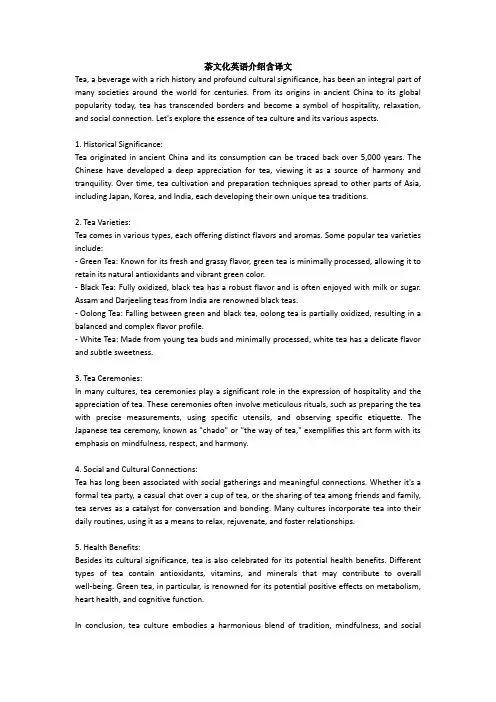
茶文化英语介绍含译文Tea, a beverage with a rich history and profound cultural significance, has been an integral part of many societies around the world for centuries. From its origins in ancient China to its global popularity today, tea has transcended borders and become a symbol of hospitality, relaxation, and social connection. Let's explore the essence of tea culture and its various aspects.1. Historical Significance:Tea originated in ancient China and its consumption can be traced back over 5,000 years. The Chinese have developed a deep appreciation for tea, viewing it as a source of harmony and tranquility. Over time, tea cultivation and preparation techniques spread to other parts of Asia, including Japan, Korea, and India, each developing their own unique tea traditions.2. Tea Varieties:Tea comes in various types, each offering distinct flavors and aromas. Some popular tea varieties include:- Green Tea: Known for its fresh and grassy flavor, green tea is minimally processed, allowing it to retain its natural antioxidants and vibrant green color.- Black Tea: Fully oxidized, black tea has a robust flavor and is often enjoyed with milk or sugar. Assam and Darjeeling teas from India are renowned black teas.- Oolong Tea: Falling between green and black tea, oolong tea is partially oxidized, resulting in a balanced and complex flavor profile.- White Tea: Made from young tea buds and minimally processed, white tea has a delicate flavor and subtle sweetness.3. Tea Ceremonies:In many cultures, tea ceremonies play a significant role in the expression of hospitality and the appreciation of tea. These ceremonies often involve meticulous rituals, such as preparing the tea with precise measurements, using specific utensils, and observing specific etiquette. The Japanese tea ceremony, known as "chado" or "the way of tea," exemplifies this art form with its emphasis on mindfulness, respect, and harmony.4. Social and Cultural Connections:Tea has long been associated with social gatherings and meaningful connections. Whether it's a formal tea party, a casual chat over a cup of tea, or the sharing of tea among friends and family, tea serves as a catalyst for conversation and bonding. Many cultures incorporate tea into their daily routines, using it as a means to relax, rejuvenate, and foster relationships.5. Health Benefits:Besides its cultural significance, tea is also celebrated for its potential health benefits. Different types of tea contain antioxidants, vitamins, and minerals that may contribute to overall well-being. Green tea, in particular, is renowned for its potential positive effects on metabolism, heart health, and cognitive function.In conclusion, tea culture embodies a harmonious blend of tradition, mindfulness, and socialconnection. With its diverse varieties, meaningful ceremonies, and health benefits, tea continues to be cherished and enjoyed by people from various cultures worldwide. Whether you're sipping a soothing cup of green tea or participating in an elaborate tea ceremony, tea invites us to appreciate the simple joys of life and embrace moments of tranquility.译文:茶是一种具有悠久历史和深厚文化意义的饮料,几个世纪以来一直是世界各地许多社会不可或缺的一部分。

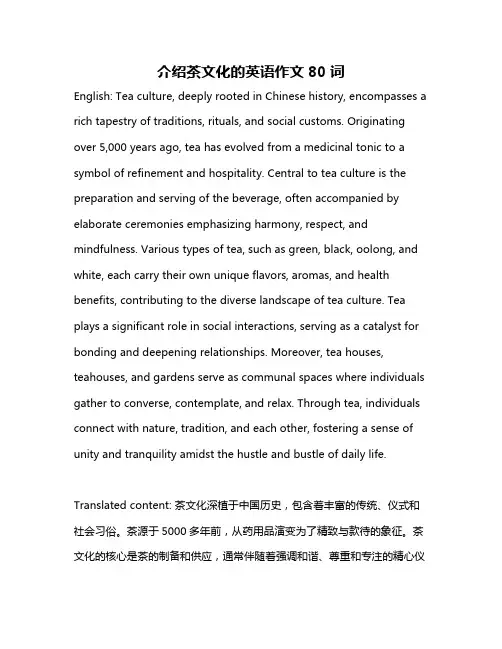
介绍茶文化的英语作文80词English: Tea culture, deeply rooted in Chinese history, encompasses a rich tapestry of traditions, rituals, and social customs. Originating over 5,000 years ago, tea has evolved from a medicinal tonic to a symbol of refinement and hospitality. Central to tea culture is the preparation and serving of the beverage, often accompanied by elaborate ceremonies emphasizing harmony, respect, and mindfulness. Various types of tea, such as green, black, oolong, and white, each carry their own unique flavors, aromas, and health benefits, contributing to the diverse landscape of tea culture. Tea plays a significant role in social interactions, serving as a catalyst for bonding and deepening relationships. Moreover, tea houses, teahouses, and gardens serve as communal spaces where individuals gather to converse, contemplate, and relax. Through tea, individuals connect with nature, tradition, and each other, fostering a sense of unity and tranquility amidst the hustle and bustle of daily life.Translated content: 茶文化深植于中国历史,包含着丰富的传统、仪式和社会习俗。
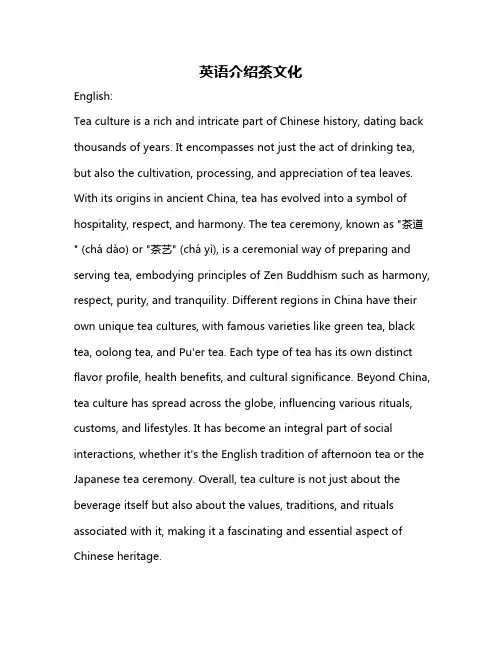
英语介绍茶文化English:Tea culture is a rich and intricate part of Chinese history, dating back thousands of years. It encompasses not just the act of drinking tea, but also the cultivation, processing, and appreciation of tea leaves. With its origins in ancient China, tea has evolved into a symbol of hospitality, respect, and harmony. The tea ceremony, known as "茶道" (chá dào) or "茶艺" (chá yì), is a ceremonial way of preparing and serving tea, embodying principles of Zen Buddhism such as harmony, respect, purity, and tranquility. Different regions in China have their own unique tea cultures, with famous varieties like green tea, black tea, oolong tea, and Pu'er tea. Each type of tea has its own distinct flavor profile, health benefits, and cultural significance. Beyond China, tea culture has spread across the globe, influencing various rituals, customs, and lifestyles. It has become an integral part of social interactions, whether it's the English tradition of afternoon tea or the Japanese tea ceremony. Overall, tea culture is not just about the beverage itself but also about the values, traditions, and rituals associated with it, making it a fascinating and essential aspect of Chinese heritage.中文翻译:茶文化是中国历史上丰富而复杂的一部分,可以追溯到几千年前。

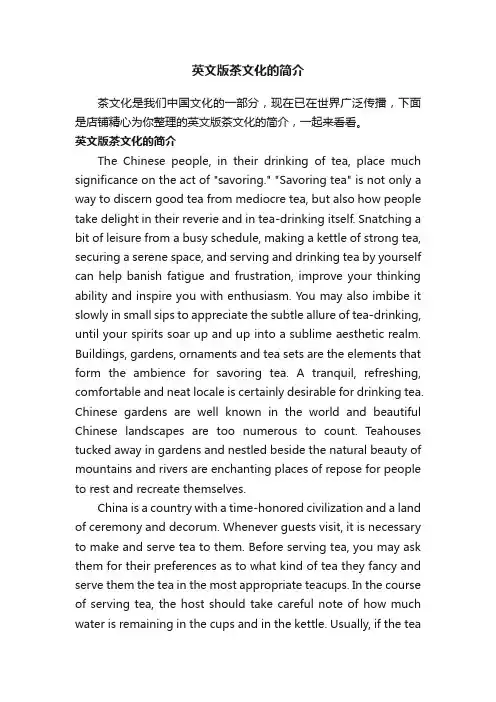
英文版茶文化的简介茶文化是我们中国文化的一部分,现在已在世界广泛传播,下面是店铺精心为你整理的英文版茶文化的简介,一起来看看。
英文版茶文化的简介The Chinese people, in their drinking of tea, place much significance on the act of "savoring." "Savoring tea" is not only a way to discern good tea from mediocre tea, but also how people take delight in their reverie and in tea-drinking itself. Snatching a bit of leisure from a busy schedule, making a kettle of strong tea, securing a serene space, and serving and drinking tea by yourself can help banish fatigue and frustration, improve your thinking ability and inspire you with enthusiasm. You may also imbibe it slowly in small sips to appreciate the subtle allure of tea-drinking, until your spirits soar up and up into a sublime aesthetic realm. Buildings, gardens, ornaments and tea sets are the elements that form the ambience for savoring tea. A tranquil, refreshing, comfortable and neat locale is certainly desirable for drinking tea. Chinese gardens are well known in the world and beautiful Chinese landscapes are too numerous to count. T eahouses tucked away in gardens and nestled beside the natural beauty of mountains and rivers are enchanting places of repose for people to rest and recreate themselves.China is a country with a time-honored civilization and a land of ceremony and decorum. Whenever guests visit, it is necessary to make and serve tea to them. Before serving tea, you may ask them for their preferences as to what kind of tea they fancy and serve them the tea in the most appropriate teacups. In the course of serving tea, the host should take careful note of how much water is remaining in the cups and in the kettle. Usually, if the teais made in a teacup, boiling water should be added after half of the cup has been consumed; and thus the cup is kept filled so that the tea retains the same bouquet and remains pleasantly warm throughout the entire course of tea-drinking. Snacks, sweets and other dishes may be served at tea time to complement the fragrance of the tea and to allay one's hunger.中国人饮茶,注重一个"品"字。
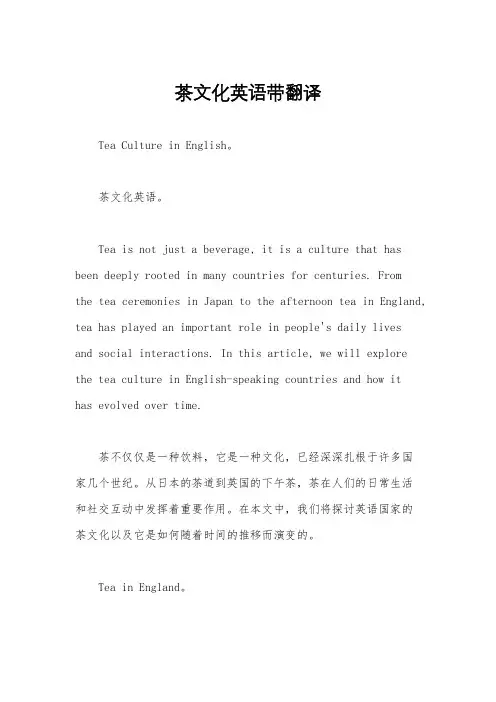
茶文化英语带翻译Tea Culture in English。
茶文化英语。
Tea is not just a beverage, it is a culture that has been deeply rooted in many countries for centuries. Fromthe tea ceremonies in Japan to the afternoon tea in England, tea has played an important role in people's daily livesand social interactions. In this article, we will explore the tea culture in English-speaking countries and how ithas evolved over time.茶不仅仅是一种饮料,它是一种文化,已经深深扎根于许多国家几个世纪。
从日本的茶道到英国的下午茶,茶在人们的日常生活和社交互动中发挥着重要作用。
在本文中,我们将探讨英语国家的茶文化以及它是如何随着时间的推移而演变的。
Tea in England。
英国的茶文化。
Tea has been a popular beverage in England since the17th century, when it was introduced by Catherine of Braganza, the queen consort of King Charles II. However, it was not until the 19th century that tea became a staple of British culture, thanks to the development of tea plantations in India and the reduction of its price. This led to the creation of the tradition of afternoon tea, which is still popular today.自17世纪以来,茶在英国一直是一种受欢迎的饮料,当时由查尔斯二世国王的皇后卡瑟琳·布拉干萨引入。
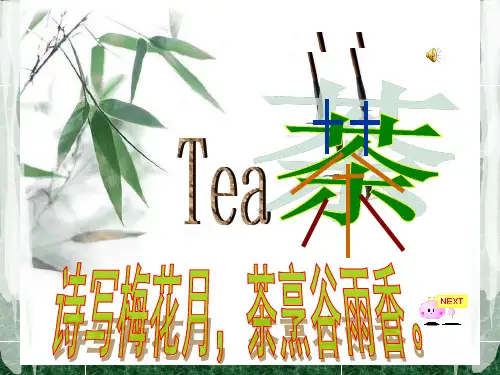

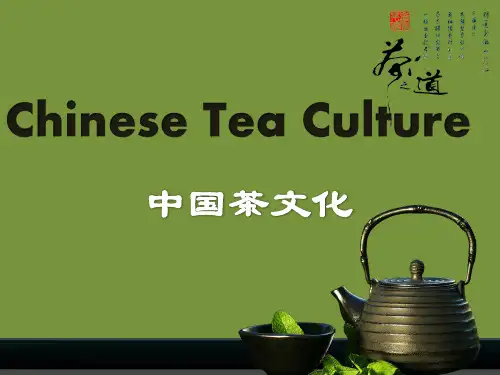

The Richness and Depth of Tea CultureTea, a beverage enjoyed by billions across the globe, is not just a drink but a culture, an art, and a way of life. Its history spans over thousands of years, with each region and culture adding its unique flavors and traditions to this ancient brew.The origins of tea are traced back to ancient China, where it was first discovered as a medicinal herb. Over time, it evolved into a beverage of choice, especially among the intellectual and elite classes. The Chinese developed various tea-making techniques and仪式, and tea became a symbol of refinement, peace, and harmony.The spread of tea culture to other countries, particularly Japan and Korea, further enriched this beverage's palette. In Japan, tea became a central part of Zen Buddhism, with tea ceremonies and rituals designed to promote tranquility and inner peace. The Japanese tea ceremony, known as "Chado," is a highly formalized and spiritualized practice that involves the preparation and consumption of tea.Tea also found its way to Europe in the 17th century, where it quickly became a fashionable beverage among the aristocracy. The British, in particular, developed a deep love for tea, and the afternoon tea became a social institution. The tradition of enjoying a cup of tea with friends or family remains popular in Britain and many other countries today.But tea is not just about the beverage; it's about the experience. The art of tea preparation, whether it's the meticulous process of making Chinese gong fu tea or the simple pleasure of brewing a cup at home, involves a senseof ritual and tranquility. It's about taking a moment to appreciate the subtleties of the tea's flavor, aroma, and color.Moreover, tea culture is about community and connection. It's about sharing a cup of tea with friends, family, or strangers, and using it as a tool to build bridges andfoster understanding. Tea has the unique ability to bring people together, transcending language and cultural barriers.In conclusion, tea culture is a rich and diverse tapestry of traditions, histories, and experiences. It's not just about drinking tea; it's about understanding the art, the history, and the spirit behind it. It's about appreciating the simple pleasures of life and finding moments of tranquility in our busy schedules. Tea culture, therefore, is not just a beverage; it's a way of life.**茶文化的丰富与深邃**茶,这一被全球数十亿人喜爱的饮品,不仅仅是一种饮料,更是一种文化、一种艺术和一种生活方式。
茶文化作文英语60词英文回答:Tea culture has a long and distinguished history in many cultures around the world. In China, tea has been cultivated for over 5,000 years and is considered a symbol of hospitality, refinement, and good luck. The Chinese tea ceremony, Gongfu tea, is a ritual that involves carefully preparing and serving tea in a specific order. In Japan, tea culture is also highly revered, with the Japanese tea ceremony, known as Chanoyu, being an important part of traditional Japanese culture. In England, tea has been enjoyed for centuries and is often associated with afternoon tea, a social gathering where people enjoy tea, sandwiches, and cakes. In many other countries, tea is also a popular beverage, with different cultures having their own unique ways of preparing and enjoying it.中文回答:茶文化在世界许多文化中拥有悠久而杰出的历史。
关于茶文化的英语茶文化(Tea culture)在中国以及其他亚洲国家有着悠久的历史和传统。
下面是一些关于茶文化的英语内容:1. 茶的起源:Tea originated in China more than 5,000 years ago. Legend has it that Emperor Shen Nong discovered tea when some tea leaves accidentally fell into his boiling water.2. 茶的种类:There are various types of tea, including green tea, black tea, oolong tea, white tea, and herbal tea. Each type has its unique taste and health benefits.3. 茶道:The art of tea drinking is known as "tea ceremony" or "tea ceremony." It involves the preparation and consumption of tea with utmost care and attention to detail. The tea ceremony is seen as a way to cultivate mindfulness and appreciating the beauty of simplicity.4. 茶具:The tea set used in the tea ceremony often includes a teapot, tea cups, a tea tray, and other utensils. These items are usually made from porcelain or clay and are intricately designed.5. 茶师:A tea master is an expert in the field of tea making and tea culture. They have extensive knowledge of different tea types, brewing techniques, and the history of tea. Tea masters are often highly respected and sought after for their expertise.6. 茶与健康:Tea is known for its health benefits. It contains antioxidants and other compounds that can help boost the immunesystem, improve digestion, and reduce the risk of certain diseases. Many people incorporate tea drinking into their daily routine for its health-promoting properties.7. 茶文化的传播:Tea culture has spread beyond Asia and has gained popularity worldwide. Many countries now have their own unique tea traditions and tea ceremonies. For example, in Japan, the tea ceremony is known as "chanoyu" and has its own set of rules and rituals.以上是关于茶文化的一些英语内容,希望能对你有所帮助!。
给外国人介绍中国传统茶文化英语作文(中英文版)Title: An Introduction to Traditional Chinese Tea CultureIn the vast and diverse tapestry of Chinese culture, tea holds a position of unique significance.It is not merely a beverage, but rather a symbol of tranquility, respect, and refined taste.The art of tea-making and appreciation is a practice that has been cultivated over thousands of years, reflecting the philosophical and aesthetic values deeply rooted in Chinese heritage.标题:介绍中国传统茶文化在中国丰富多样的文化长河中,茶文化占据着独特的地位。
它不仅仅是一种饮品,更是宁静、尊重和雅致的象征。
制茶与品茶的艺术是经过数千年沉淀的精粹,体现了深深植根于中国传统的哲学和审美价值观。
The origins of tea can be traced back to the ancient times in China, where it was not only consumed for its delightful taste and health benefits but also used in traditional medicine.The Chinese people"s love for tea has given rise to a sophisticated tea culture, which encompasses a wide array of ceremonies, customs, and etiquette that are as intricate as the flavors of the tea itself.茶的起源可追溯到中国古代,那时人们不仅因其美妙的味道和健康益处而饮用,还将其用于传统医药。
茶文化范文英语Tea is more than just a drink; it's a cultural experience that transcends time and borders. Its aroma, a blend of history and tradition, invites us to a journey of the senses.In the East, tea ceremonies are a form of art, a meditative practice that brings people together in a serene setting. Each movement is deliberate, each sip a moment of reflection.The tea leaves, whether green, black, or oolong, tell a story of the land they come from. They are carefully picked, processed, and brewed to perfection, each cup a testament to the skill of the tea master.Sipping tea is not just about quenching thirst; it's about slowing down, appreciating the subtle flavors, and engaging in conversation. It's a pause in the hustle and bustle of daily life.From the ancient Chinese dynasties to the modern world, tea has always been a symbol of hospitality and friendship.It unites people from diverse backgrounds, fostering connections over a shared cup.The ritual of tea is a reminder to be present, to savor the moment, and to find joy in the simple pleasures of life. It's a tradition that continues to evolve, yet remains deeplyrooted in our collective consciousness.In the quiet moments of tea drinking, one can find a sense of peace and tranquility that is often missing in our fast-paced world. It's a reminder to cherish the present and to appreciate the beauty in the ordinary.Tea, in its many forms, is a universal language that speaks to the heart. It's a silent conversation that transcends words, connecting us all through the shared experience of its warmth and flavor.Whether enjoyed alone for contemplation or in the company of friends for lively discussion, tea remains a timeless tradition that enriches our lives with its depth and complexity.。